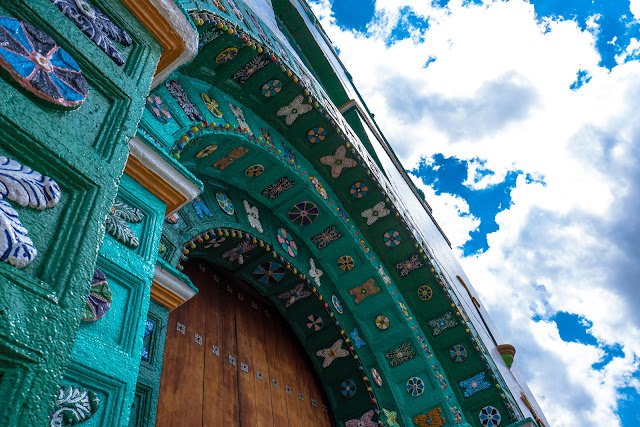Have you ever heard of the ‘Coca Cola Church’ in San Juan Chamula Mexico? I bet not, so read on.
This simple-looking church in the autonomous indigenous town of San Juan Chamula is said to be a very special and unique church on the planet. Its uniqueness, though, does not quite lie in its white green facade with a beautiful doorway decorated with multicolored butterfly and flower patterns.
The Coca Cola church of Inglesia de San Juan is different than the others in the way that it blends Catholic and Mayan traditions as the center of the Tzotzil community life.
Tzotzil Mayans are the predominant indigenous group living in San Juan Chamula town, some 10 km away from the colonial city of San Cristobal de las Casas in the Mexican state of Chiapas. These Mayan people have extremely strict rules and unorthodox practices in order to maintain their culture and traditions. As such, photography is strictly prohibited inside the Coca Cola church, but let me try to explain what I experienced and imprint on my memory.
Upon entering the so-called Coca Cola Church San Juan Chamula, the first difference you’ll possibly notice is the pine needles on the floor. There are no pews or benches, but instead, people sit on the floor much like when the ceremonies took place in the caves and forests in prehispanic times. There is no priest, no sense of collective worship. Each party of people clears a space among the pine needles to light a variety of candles stuck to the floor in rows in front of them. Once the candles are lit, they start to pray in their local Tzotzil language to one the Catholic Saints whose statues run along the sides of the church. Tzotzil Mayans believe that saints are Jesus’ siblings and pray to different ones according to their specific requests, just like their ancestors prayed to different gods for different needs.
While chanting and singing, various objects, including coke bottles, are being waved about the candles to be blessed. When the individual or individuals are suffering from a serious illness, have misplaced their souls after an accident, or are having other life issues, a curandero (a local shaman) swirls a live sacrificial animal (hen or rooster) over the ill person as part of the cleansing ceremony. It’s believed that the illness or the problem they are praying about would be transferred to the soul of the animal, which would then be killed so that the bad spirits or illness would disappear forever.
In the meanwhile the cleansing ceremony, the curandero drinks copiously, traditionally pox, a local sugar-cane based liquor, as a preventive measure to avoid the illness, along with the ill individual(s). They drink and drink until they literally burp out the illness. Once they burp, it’s believed that they have been fully cleansed of the evil, allowing them to end their prayer session. At this point, Coca Cola’s marketing strategy comes into play. They obviously managed to convince the locals that their fizzy drink is far more suitable for the purpose of burping than the traditional booze. How genius!
I personally wasn’t highly impressed by this raved Coca Cola Church and the ceremonies going on, but if you are in San Cristobal de las Casas and have a few hours to spare, it’s well worth the visit to see how Mayan traditions meet Coke (sometimes Fanta) bottles and cans. After all, where else in the world would you be able to see traditionally dressed Mayan people sitting on a pad of pine needles, praying in an ancient tongue, drinking fizzy beverages, burping out loud and killing chickens in an eerily lit church full of Catholic Saint statues?







